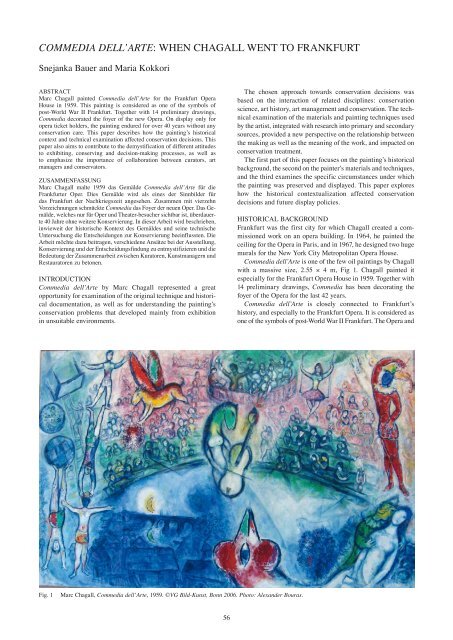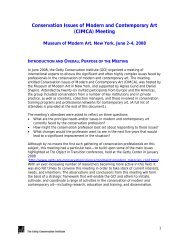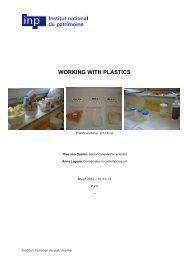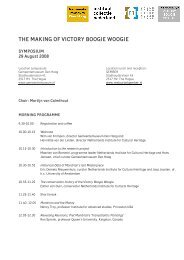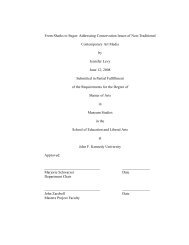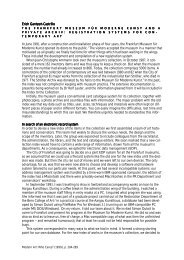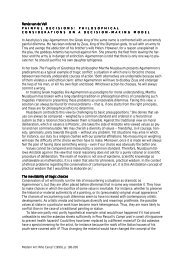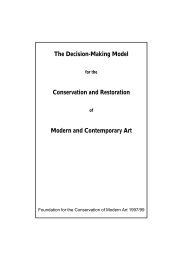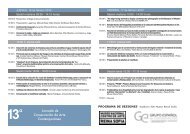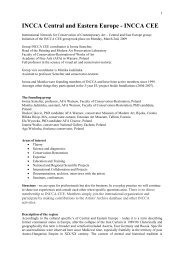commedia dell'arte: when chagall went to frankfurt - incca
commedia dell'arte: when chagall went to frankfurt - incca
commedia dell'arte: when chagall went to frankfurt - incca
You also want an ePaper? Increase the reach of your titles
YUMPU automatically turns print PDFs into web optimized ePapers that Google loves.
COMMEDIA DELL’ARTE: WHEN CHAGALL WENT TO FRANKFURT<br />
Snejanka Bauer and Maria Kokkori<br />
ABSTRACT<br />
Marc Chagall painted Commedia dell’Arte for the Frankfurt Opera<br />
House in 1959. This painting is considered as one of the symbols of<br />
post-World War II Frankfurt. Together with 14 preliminary drawings,<br />
Commedia decorated the foyer of the new Opera. On display only for<br />
opera ticket holders, the painting endured for over 40 years without any<br />
conservation care. This paper describes how the painting’s his<strong>to</strong>rical<br />
context and technical examination affected conservation decisions. This<br />
paper also aims <strong>to</strong> contribute <strong>to</strong> the demystification of different attitudes<br />
<strong>to</strong> exhibiting, conserving and decision-making processes, as well as<br />
<strong>to</strong> emphasize the importance of collaboration between cura<strong>to</strong>rs, art<br />
managers and conserva<strong>to</strong>rs.<br />
ZUSAMMENFASSUNG<br />
Marc Chagall malte 1959 das Gemälde Commedia dell’Arte für die<br />
Frankfurter Oper. Dies Gemälde wird als eines der Sinnbilder für<br />
das Frankfurt der Nachkriegszeit angesehen. Zusammen mit vierzehn<br />
Vorzeichnungen schmückte Commedia das Foyer der neuen Oper. Das Gemälde,<br />
welches nur für Oper und Theater-besucher sichtbar ist, überdauerte<br />
40 Jahre ohne weitere Konservierung. In dieser Arbeit wird beschrieben,<br />
inwieweit der his<strong>to</strong>rische Kontext des Gemäldes und seine technische<br />
Untersuchung die Entscheidungen zur Konservierung beeinflussten. Die<br />
Arbeit möchte dazu beitragen, verschiedene Ansätze bei der Ausstellung,<br />
Konservierung und der Entscheidungsfindung zu entmystifizieren und die<br />
Bedeutung der Zusammenarbeit zwischen Kura<strong>to</strong>ren, Kunstmanagern und<br />
Restaura<strong>to</strong>ren zu be<strong>to</strong>nen.<br />
INTRODUCTION<br />
Commedia dell’Arte by Marc Chagall represented a great<br />
opportunity for examination of the original technique and his<strong>to</strong>rical<br />
documentation, as well as for understanding the painting’s<br />
conservation problems that developed mainly from exhibition<br />
in unsuitable environments.<br />
The chosen approach <strong>to</strong>wards conservation decisions was<br />
based on the interaction of related disciplines: conservation<br />
science, art his<strong>to</strong>ry, art management and conservation. The technical<br />
examination of the materials and painting techniques used<br />
by the artist, integrated with research in<strong>to</strong> primary and secondary<br />
sources, provided a new perspective on the relationship between<br />
the making as well as the meaning of the work, and impacted on<br />
conservation treatment.<br />
The first part of this paper focuses on the painting’s his<strong>to</strong>rical<br />
background, the second on the painter’s materials and techniques,<br />
and the third examines the specific circumstances under which<br />
the painting was preserved and displayed. This paper explores<br />
how the his<strong>to</strong>rical contextualization affected conservation<br />
decisions and future display policies.<br />
HISTORICAL BACKGROUND<br />
Frankfurt was the first city for which Chagall created a commissioned<br />
work on an opera building. In 1964, he painted the<br />
ceiling for the Opera in Paris, and in 1967, he designed two huge<br />
murals for the New York City Metropolitan Opera House.<br />
Commedia dell’Arte is one of the few oil paintings by Chagall<br />
with a massive size, 2.55 × 4 m, Fig 1. Chagall painted it<br />
especially for the Frankfurt Opera House in 1959. Together with<br />
14 preliminary drawings, Commedia has been decorating the<br />
foyer of the Opera for the last 42 years.<br />
Commedia dell’Arte is closely connected <strong>to</strong> Frankfurt’s<br />
his<strong>to</strong>ry, and especially <strong>to</strong> the Frankfurt Opera. It is considered as<br />
one of the symbols of post-World War II Frankfurt. The Opera and<br />
Fig. 1<br />
Marc Chagall, Commedia dell’Arte, 1959. ©VG Bild-Kunst, Bonn 2006. Pho<strong>to</strong>: Alexander Bouras.<br />
56
the theatre were both housed in a building called the ‘Schauspielhaus’.<br />
This magnificent Art Nouveau building dating from 1902 was<br />
badly damaged by 1945; this unfortunately had happened <strong>to</strong> the<br />
majority of the buildings in the city of Frankfurt at the end of World<br />
War II, many being <strong>to</strong>tally destroyed by numerous bombings.<br />
During the 1950s, the his<strong>to</strong>rically important buildings were reconstructed.<br />
The Opera and Theatre House was opened for visi<strong>to</strong>rs in<br />
1951 and reconstruction began during 1954.<br />
The building, however, proved <strong>to</strong> be <strong>to</strong>o small <strong>to</strong> host both the<br />
opera and the theatre. As a result, in 1958 the decision was taken<br />
<strong>to</strong> make a separate opera building. The old Art Nouveau shell<br />
was replaced by a glass façade. The architect of the new façade<br />
was Ot<strong>to</strong> Apl. In 1958 Chagall was asked <strong>to</strong> create a painting for<br />
the opera foyer of this very new building.<br />
On 16 January 1958, Chagall accepted the commission and<br />
started with the preparation of the awesome painting: he designed<br />
about 17 preliminary drawings. One of them was chosen<br />
as the final draft in September of the same year. Chagall chose<br />
the title of the painting himself: Commedia dell’Arte. One year<br />
later, on 16 December 1959, the painting was finished and signed<br />
by the artist.<br />
Because of the size of the painting, it was rolled up and transferred<br />
from France <strong>to</strong> Frankfurt by train. Unfortunately, <strong>when</strong><br />
the painting arrived in Frankfurt, the new Opera building was<br />
not yet ready and thus began the ‘odyssey’.<br />
For several weeks, the painting remained rolled and<br />
unattended in the s<strong>to</strong>rage rooms of a transport company until<br />
the Frankfurt Städelsches Kunstinstitut transferred it <strong>to</strong> its<br />
s<strong>to</strong>rage rooms and stretched it after almost eight months — a<br />
fact discovered during conservation treatment from an inscription<br />
on the inner side of the stretcher. In November 1960, the<br />
Frankfurt Städelsches Kunstinstitut organized the first exhibition<br />
show of the Commedia <strong>to</strong>gether with the 17 drafts. Three years<br />
later, in 1963, Frankfurt bought 14 of these drawings and from<br />
14 December 1963 the whole Commedia group was on display<br />
in the foyer of the new Opera House. Opera visi<strong>to</strong>rs could admire<br />
the wonderful painting, which is actually the biggest painting by<br />
Chagall in Germany.<br />
Unfortunately, in 1987, a fire occurred and a large part of<br />
the new opera building was burned down. It was a miracle that<br />
the Commedia group was not damaged. During the reconstruction<br />
of the building the Commedia group was evacuated. From<br />
1988 until 1991, Commedia decorated the entrance hall of the<br />
Frankfurter Volksbank.<br />
THE WORD AS STAGE: THE COMMEDIA<br />
Commedia dell’Arte plays a catalytic role in the exceptionally<br />
fertile chapter of Chagall’s theatre paintings. The circus was<br />
one of Chagall’s favourite subjects during his early years in<br />
Paris and henceforth throughout his career [1]. His experience<br />
and memory of clowns, acrobats, and young ladies on horseback<br />
lay at the heart of his personal mythology. He joined a long<br />
and distinguished line of post-Impressionist and modern<br />
painters who featured the circus in their work, including Seurat,<br />
Toulouse-Lautrec, Picasso, Rouault, van Dongen and Léger.<br />
In Commedia dell’Arte, all of Chagall’s favourite performers<br />
are here, <strong>to</strong>gether with an orchestra and audience. Chagall’s<br />
circus pictures are usually filled with brilliant colour and<br />
exuberant activity, being especially joyous and life-affirming.<br />
He wrote in 1967:<br />
For me, a circus is a magic show that appears and disappears<br />
like a world. A circus is disturbing. It is profound. . . . These<br />
clowns, bareback riders and acrobats have themselves a home<br />
in my visions. Why? Why am I so <strong>to</strong>uched by their make-up<br />
and their grimaces? With them, I can move <strong>to</strong>ward new<br />
horizons. Lured by their colours and make-up, I can dream of<br />
painting new psychic dis<strong>to</strong>rtions. . . . It is a magic word, circus,<br />
a timeless dancing game where tears and smiles, the play of<br />
arms and legs take the form of a great art. . . . I would like <strong>to</strong><br />
go up <strong>to</strong> that bareback rider who has just disappeared, smiling;<br />
her dress a bouquet of flowers. I would circle her with my<br />
flowered and unflowered years. On my knees, I would tell her<br />
wishes and dreams, not of this world. I would run after her <strong>to</strong><br />
ask her how <strong>to</strong> live, how <strong>to</strong> escape from myself, from the world,<br />
whom <strong>to</strong> run <strong>to</strong>, where <strong>to</strong> go. . . . I have always thought of<br />
clowns, acrobats and ac<strong>to</strong>rs, as tragically, human beings who,<br />
for me, are like characters in certain religious paintings [2].<br />
A close examination of this painting and a comparison with<br />
the closely-related preliminary works, allows us <strong>to</strong> understand<br />
better how the painting was conceived and executed.<br />
Chagall used a medium-weight, plain weave, linen-type canvas.<br />
The thin, evenly-applied ground layer suggests that it is more<br />
likely that Chagall used a single-primed canvas that was commercially<br />
available. Scanning electron microscopy with energydispersive<br />
X-ray analysis (SEM-EDX) indicated the presence<br />
of lead and zinc in the ground along with calcium (carbonate),<br />
bound in oil. It is conceivable that Chagall desired a pure white<br />
ground for its optical effect, particularly as it was allowed <strong>to</strong> show<br />
in some areas of the composition.<br />
Chagall worked on many prepara<strong>to</strong>ry drawings and sketches<br />
for Commedia dell’Arte; he designed about 17 preliminary works.<br />
These studies permitted Chagall <strong>to</strong> map out his final composition<br />
with very few changes. Examination of the painting with infrared<br />
reflec<strong>to</strong>graphy has shown clear and continuous brushstrokes of<br />
black paint outlining the design. These lines vary in length and<br />
thickness. The painting shows the sense of immediacy and spontaneity<br />
commonly associated with Chagall’s painting technique.<br />
These outlines are sparse linear frameworks with very little, if<br />
any, shading or development of form. Meyer wrote :<br />
. . . After welcoming us, he would return <strong>to</strong> his work and<br />
sit down in front of his easel, imbued by the light coming<br />
through the large bay window. He would pick up a few long<br />
brushes with great deliberation, and proceed <strong>to</strong> place paint<br />
on<strong>to</strong> the canvas in a most delicate, precise and quick fashion,<br />
similar <strong>to</strong> a dance; he would call it picoter, <strong>to</strong> peck. It was<br />
amazing <strong>to</strong> watch him paint with such energy . . . [3].<br />
Colour is applied more or less thickly; and broad brushstrokes<br />
are clearly visible. Paint is used as a source of texture as well as<br />
colour. The variations in texture further activate the composition.<br />
Fig. 2<br />
Detail showing alterations <strong>to</strong> the face. ©VG Bild-Kunst, Bonn<br />
2006. Pho<strong>to</strong>: Alexander Bouras.<br />
57
Fig. 5 Detail showing the painting texture. ©VG Bild-Kunst, Bonn 2006.<br />
Pho<strong>to</strong>: Alexander Bouras.<br />
Fig. 3<br />
Detail showing a figure holding an umbrella almost erased and<br />
covered with thin layers of paint. ©VG Bild-Kunst, Bonn 2006.<br />
Pho<strong>to</strong>: Alexander Bouras.<br />
Fig. 4<br />
Detail showing different types of brushstrokes. ©VG Bild-Kunst,<br />
Bonn 2006. Pho<strong>to</strong>: Alexander Bouras.<br />
Fig. 6<br />
Detail showing the texture of a face. ©VG Bild-Kunst, Bonn<br />
2006. Pho<strong>to</strong>: Alexander Bouras.<br />
Chagall experimented with mixed media. There are areas where<br />
he combines oil with wood dust, thus creating a grittier texture<br />
and vibrancy.<br />
The paint layering is complex and reflects numerous changes<br />
and reworkings, as well as the diversity of Chagall’s brushwork<br />
and paint formulation. These colour changes were made alla<br />
prima, not in such a way that a lower layer affects the appearance<br />
of an upper layer. The thickness and opacity of the final layers<br />
indicated a decisive change in the colour relationships. Another<br />
way Chagall created interesting colour effects and textures is<br />
by overlayering comparably thick and strongly coloured paint<br />
layers. He also used ink and mixtures of oil paint with varnish<br />
in order <strong>to</strong> create different matt and glossy areas. It is difficult <strong>to</strong><br />
determine how many of these effects came in<strong>to</strong> being as a sideeffect<br />
of the continual painterly metamorphosis and how much<br />
of it was planned or ‘intended’.<br />
Many parts of the paintings were altered during the painting<br />
procedure. This became clear from infrared reflec<strong>to</strong>graphy where<br />
it was found that certain face characteristics were repainted<br />
(Fig. 2), small figures were almost erased and covered with thin<br />
layers of paint (Fig. 3) and also some preliminary compositional<br />
elements were completely changed.<br />
Chagall used his brushes <strong>to</strong> form strokes of many different<br />
sizes and shapes, oriented in various directions <strong>to</strong> delineate<br />
form and create movement. He seems <strong>to</strong> change his brushstrokes<br />
according <strong>to</strong> the amount of detail desired, or the prominence<br />
58
and emphasizing the differences in the physical traits of the<br />
theatrical figures.<br />
Fig. 7<br />
of the motif. The brushwork includes thick, wide, well-defined<br />
strokes; smooth passages with little hint of any brushstrokes;<br />
areas where the artist had manipulated the brush in order <strong>to</strong><br />
create local areas of high impas<strong>to</strong>; and areas where a palette<br />
knife was used, Fig. 4.<br />
The colours were worked out and refined as the painting<br />
progressed. Chagall’s characteristic manipulation of the paint<br />
materials and his awareness of each pigment’s nuance of colour<br />
suggest that he was also very involved with the raw materials and<br />
their physical properties.<br />
There are areas where the paint has been heavily worked<br />
as it was built up in many layers, resulting in a somewhat dry<br />
and pasty texture. Soft, irregular blotches of paint were used,<br />
producing a mottled, indefinite effect, Figs 5 and Fig. 6.<br />
Chagall’s palette was composed largely of strong, spectrallypure<br />
colours: cobalt blue, French ultramarine, vermilion, cadmium<br />
yellow, viridian, emerald green, lead white and zinc white.<br />
Mixtures of these pigments are also found <strong>to</strong> give other reds,<br />
oranges, greens, purples and occasionally, browns and blacks. In<br />
addition, other pigments were identified, such as red and yellow<br />
ochres, Naples yellow and Prussian blue. Analyses indicated that<br />
similar pigments were used for both the preliminary drawings<br />
and the Commedia dell’Arte.<br />
Chagall managed <strong>to</strong> explore and obtain the most effective and<br />
vibrant colour contrasts. The result is a surface texture of great<br />
variety and complexity, providing tension in the composition<br />
Fig. 8<br />
Neue Opera lobby with south-facing window glazing. VG Bild-<br />
Kunst, Bonn 2006. Pho<strong>to</strong>: Alexander Bouras.<br />
Neue Opera: the entertainment area, showing the location<br />
of Commedia dell’Arte. VG Bild-Kunst, Bonn 2006. Pho<strong>to</strong>:<br />
Alexander Bouras.<br />
THE OPERA HOUSE ENVIRONMENT<br />
Commedia dell’Arte has always being regarded as a decorative<br />
object for an entertainment area — available only for Opera ticket<br />
holders — where smoking, drinking and eating is allowed.<br />
Large areas of the new Opera building are predominantly<br />
illuminated by daylight — one of the most notable features of<br />
the building. Although daylight can be considered superior <strong>to</strong><br />
any other kind of illumination, its control is difficult <strong>to</strong> reconcile<br />
with conservation demands.<br />
The lobby with its south-facing window glazing has the<br />
highest level of illumination. Both Commedia dell’Arte and the<br />
14 preliminary drawings were displayed just opposite these<br />
windows. It appears that the difficulties that might arise in coping<br />
with natural daylight were not anticipated at an early stage in<br />
the design of the building. On sunny days, the temperature in<br />
the exhibition area also rises dramatically, Fig. 7. Although<br />
conservation standards for works of art on display are published<br />
in a number of books [4, 5], the presence of a conserva<strong>to</strong>r <strong>to</strong><br />
moni<strong>to</strong>r day-<strong>to</strong>-day light and climate conditions is absolutely<br />
necessary.<br />
As in any building which is not designed <strong>to</strong> house works of art,<br />
temperature and relative humidity (RH) are very unstable. The<br />
uncontrollable number of people entering the room during the<br />
opera intervals contributes <strong>to</strong> extra fluctuations in temperature<br />
and RH. The bar area just opposite Commedia, equipped with<br />
two steam coffee machines, is always overcrowded during opera<br />
intervals, Fig. 8. In addition, due <strong>to</strong> the function of this area, it<br />
also appears very difficult <strong>to</strong> control the amount of dirt and dust<br />
as well as noise and vibration.<br />
Finally, hanging such a large and heavy painting inclined<br />
away from the wall posed many challenges and great potential<br />
for serious damage. The installation of Commedia dell’Arte at<br />
the new Opera House created a number of structural problems<br />
<strong>to</strong> the painting.<br />
CONSERVATION TREATMENT<br />
Very little documentation exists in the His<strong>to</strong>rische Museum<br />
records on the condition of Commedia dell’Arte over the years<br />
since its arrival in Frankfurt in 1959. The records that exist<br />
relate <strong>to</strong> the exhibition his<strong>to</strong>ry of the painting and the 14<br />
preliminary drawings. Commedia dell’Arte was pho<strong>to</strong>graphed<br />
and assessed, condition reports were compiled and treatment<br />
proposals formulated as a result of discussions between cura<strong>to</strong>r<br />
and conserva<strong>to</strong>rs.<br />
The stretcher is a seven-member wooden one, with a central<br />
horizontal bar and two vertical ones. The dimensions of the painting<br />
represent those of the stretcher added during framing in 1960<br />
just prior <strong>to</strong> its exhibition. The tacking margins indicate that the<br />
painting was extended by approximately 2 cm on each side. Due<br />
<strong>to</strong> the display system in the Opera House, hanging caused the<br />
stretcher <strong>to</strong> warp slightly and the canvas <strong>to</strong> sag. The condition of<br />
the stretcher was found <strong>to</strong> be sound, and because of its his<strong>to</strong>rical<br />
significance, it was decided not <strong>to</strong> replace it.<br />
The first step was <strong>to</strong> remove a layer of superficial airborne<br />
grime that had accumulated, since the work had never been<br />
surface cleaned. This treatment also allowed the surface <strong>to</strong> be<br />
examined closely in order <strong>to</strong> detect any minor damages that may<br />
have been overlooked. Dust, atmospheric pollutants and dirt were<br />
removed using saliva. Other cleaning solutions tested included<br />
deionized water and 2% tri-ammonium citrate in deionized water,<br />
but none of these cleaning agents removed dirt as much as the<br />
cleaning agent chosen. The procedure began by testing a small<br />
area of the painting judged <strong>to</strong> be least noticeable. At each step of<br />
59
the treatment, the painting was carefully examined for changes in<br />
gloss, or colour pick-up on the swab. All dirt and residues have<br />
been removed from the surface, allowing Chagall’s true palette<br />
and methods of paint handling <strong>to</strong> be appreciated. The surface<br />
has regained a freshness and vitality, as if a grey filter had been<br />
removed from the front of the painting.<br />
The painting canvas had begun <strong>to</strong> show the familiar signs of<br />
deterioration. The tacking edges of Commedia dell’Arte were<br />
found <strong>to</strong> be more damaged than the bulk of the canvas, because<br />
of the effect of the rusted tacks and resinous wood. In order <strong>to</strong><br />
reinforce the original edges strip-lining was carried out using<br />
polyester canvas and BEVA 371 adhesive.<br />
Additional support was provided <strong>to</strong> the painting in the form of<br />
a loose lining — a polyester fabric stretched and secured <strong>to</strong> the<br />
original stretcher. The painting was then re-secured <strong>to</strong> the stretcher<br />
so that it rested against the polyester fabric. Loose-lining was<br />
chosen as one of the most effective preventive measures for the<br />
painting. An extra advantage was that the original stretcher could<br />
be retained and preserved by this system, and the <strong>to</strong>tal weight<br />
was only increased by a very small amount.<br />
Any idea of varnishing the painting was rejected, as it is felt<br />
that the painting should remain unvarnished for a more appropriate<br />
appearance, allowing Chagall’s considerable technical<br />
prowess and vision <strong>to</strong> be appreciated fully. Both cura<strong>to</strong>r and conserva<strong>to</strong>rs<br />
agreed the painting had not been varnished originally,<br />
in keeping with Chagall’s intention that the paint surface should<br />
retain its natural variation in matt and gloss.<br />
Framing is a very important preventive measure. The<br />
application of backboards, the strengthening of frames <strong>to</strong> ensure<br />
rigidity, and the application of low reflecting glass <strong>when</strong>ever<br />
possible, provide effective mechanical protection and ensure a<br />
microclimate around each work. A Fome-Cor backboard was<br />
screwed <strong>to</strong> the reverse of the stretcher in order <strong>to</strong> slow moisture<br />
transport through the canvas, keep out dust and foreign objects,<br />
and protect against damage during handling. Commedia dell’Arte<br />
was installed after conservation treatment in a metal frame, in<br />
which almost the entire painted surface is visible. As Chagall<br />
painted the image right up <strong>to</strong> the very edge of the canvas in many<br />
places, displaying as much of the canvas as possible is important.<br />
This frame provides rigidity and the strength needed for the<br />
painting’s large format, its heavy weight and fragile materials,<br />
so as <strong>to</strong> minimize deformation or vibration during exhibition or<br />
transportation.<br />
DISCUSSION<br />
Commedia dell’Arte had been displayed for over 40 years<br />
without any conservation care. Far from any scientific approach,<br />
it had been regarded as a decorative object: it was exposed <strong>to</strong><br />
direct sunlight, cigarette smoke and steam from coffee<br />
machines.<br />
Conserving Commedia dell’Arte required careful planning<br />
based on his<strong>to</strong>rical criteria and detailed knowledge of the work<br />
and its components as well as respect for the artist’s intentions<br />
[6]. The technical examination of the materials and painting<br />
techniques used by Chagall, integrated with an analysis of his<br />
theoretical and practical aims as expressed in the artist’s writings,<br />
and the comments and practices of his contemporaries, revealed<br />
and explored the interrelationship between materials, techniques<br />
and artistic expression. The following questions were the most<br />
interesting. Which painting materials and technique did the artist<br />
use? Did he create new forms by experimentation? Where did he<br />
find his stimulus for the choice of materials and techniques and<br />
in what way are these modified within the artistic process? What<br />
was his theoretical and practical aim?<br />
We tried <strong>to</strong> focus on measures and treatments that could meet<br />
the meaning, function and requirements of the painting. Any<br />
conservation project is a complex undertaking, full of risks and<br />
difficulties. A wide range of problems was posed by the variety<br />
of materials used in this work and also by the way the painting<br />
was exhibited.<br />
Apart from issues related <strong>to</strong> conservation treatment procedures,<br />
there were also other structural considerations that were<br />
discussed. These concerned the durability of the work and its<br />
ultimate display. Is the Neue Opera providing a suitable environment<br />
for the painting? How could the environmental conditions<br />
be improved? Should the painting be transferred <strong>to</strong> another<br />
exhibition space? How is Commedia dell’Arte placed in the<br />
physical and social context of the Opera House? Whenever one<br />
turns <strong>to</strong> discussing the display of artefacts in an exhibition place<br />
there is the issue of epistemology, of how artefacts are perceived<br />
and presented by the cura<strong>to</strong>r, how they are preserved by the<br />
conserva<strong>to</strong>r and of how they are perceived and unders<strong>to</strong>od by<br />
the visi<strong>to</strong>r. It becomes clear that this highly fluid and complex<br />
activity is not susceptible <strong>to</strong> straightforward definition: the<br />
painting has <strong>to</strong> be seen in its his<strong>to</strong>rical context; cura<strong>to</strong>rs have a<br />
particular and personal representation of his<strong>to</strong>rical and aesthetic<br />
significance; conserva<strong>to</strong>rs are responsible for the preservation<br />
of works and maintenance of the most important property<br />
of a painting, its lifespan. The painting does not continue <strong>to</strong><br />
exist of its own accord: on the contrary, it is susceptible <strong>to</strong><br />
multiple constructions of meaning dependent upon, among other<br />
fac<strong>to</strong>rs, its visual and his<strong>to</strong>rical representation, albeit the whole<br />
environment in which it exists.<br />
The importance of collaboration between cura<strong>to</strong>rs, art<br />
his<strong>to</strong>rians, art managers and painting conserva<strong>to</strong>rs was<br />
apparent in all discussions related <strong>to</strong> the past, present and future<br />
of Commedia dell’Arte, and this multi-disciplinary approach<br />
bridged the different mindsets involved in exhibiting, conserving<br />
and making decisions.<br />
ACKNOWLEDGEMENTS<br />
The authors are grateful <strong>to</strong> Meret Meyer, the Chagall Committee,<br />
Heinz Vogel, Adolf and Luisa Haeuser-Stiftung, Dr Richard Zacharuk,<br />
Alexandra Neubauer, Alexander Bouras, Manjit Debashis, Natasha<br />
Duff, Barbara Hassel, Julia Spies and Jana Zarlung for their invaluable<br />
participation <strong>to</strong> this project.<br />
SUPPLIERS<br />
Fome-Cor: Alcan International Network Deutschland GmbH,<br />
Fritz-Vomfelde-Str. 12, 40547 Düsseldorf, Germany.<br />
Pigments: Kremer Pigmente GmbH & Co. KG Hauptstrasse 41−47,<br />
D-88317 Aichstetten, Germany.<br />
Plex<strong>to</strong>l B500: Polymer Latex GmbH, KG 45764 Marl, Germany.<br />
BEVA 371: Conserva<strong>to</strong>r’s Products Company, P.O. Box 601, Flanders,<br />
New Jersey 07836, USA.<br />
REFERENCES<br />
1 Shatskikh, A., ‘The Theatre in the Biography of Marc Chagall’, in<br />
Marc Chagall: ‘Bonjour, la patrie!’, exhibition catalogue, ed. B.<br />
Yakov, Tretiakov Gallery, Moscow (2005) 100−109.<br />
2 Baal-Teshuva, J., (ed.), Chagall: A Retrospective, Hugh Lauter<br />
Levin, New York (1995) 196−198.<br />
3 Meyer, B., ‘Chagall in Moscow’, in Marc Chagall: ‘Bonjour, la<br />
patrie!’, exhibition catalogue, ed. B. Yakov, Tretiakov Gallery,<br />
Moscow (2005) 16–18.<br />
4 S<strong>to</strong>low, N., Conservation and Exhibitions, Butterworths, London<br />
(1987).<br />
5 Thomson, G., The Museum Environment, 2nd edn, Butterworths,<br />
London (1986).<br />
6 Leonard, M., (ed.), Personal Viewpoints: Thoughts about<br />
Painting Conservation, Getty Conservation Institute, Los Angeles<br />
(2003).<br />
60
AUTHORS<br />
Snejanka Bauer is a cura<strong>to</strong>r at the Iconen Museum of Frankfurt am Main.<br />
She has studied art his<strong>to</strong>ry in Sofia (Bulgaria) and Berlin. She received<br />
her doc<strong>to</strong>rate in art his<strong>to</strong>ry from the Humboldt University, Berlin. She<br />
has published widely, and her research interests include contemporary<br />
art, icon painting, art under National Socialism, and the Munich School.<br />
She has lectured as a visiting scholar at the University of Sofia and at the<br />
Louvre, Paris. Address: Ikonen Museum der Stadt Frankfurt-Stiftung Dr.<br />
Schmidt-Voigt, Brückenstraße 3-7, 60594 Frankfurt am Main, Germany.<br />
E-mail: snejanka.bauer@stadt-<strong>frankfurt</strong>.de<br />
Maria Kokkori is completing her doc<strong>to</strong>ral thesis entitled Russian Avant-<br />
Garde: A his<strong>to</strong>rical contextualization of selected paintings by Kazimir<br />
Malevich, Ivan Kliun and Liubov Popova c.1905−1925 at the Courtauld<br />
Institute of Art, London. She received a BSc in chemistry from the<br />
University of Athens in 1994 and a MA in the conservation of easel<br />
paintings from Northumbria University in 1997. She was a Gerry<br />
Hedley Fellow at the Courtauld Institute of Art in 1998−2000. Address:<br />
Courtauld Institute of Art, Somerset House, Strand, WC2R 0RN,<br />
London, UK. Email: marie.kokkori@courtauld.ac.uk<br />
61


